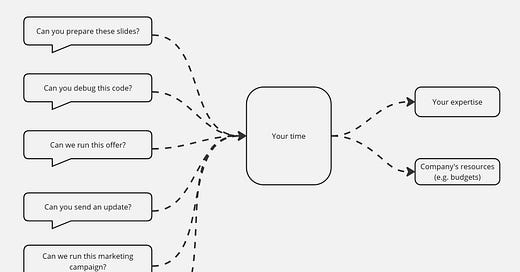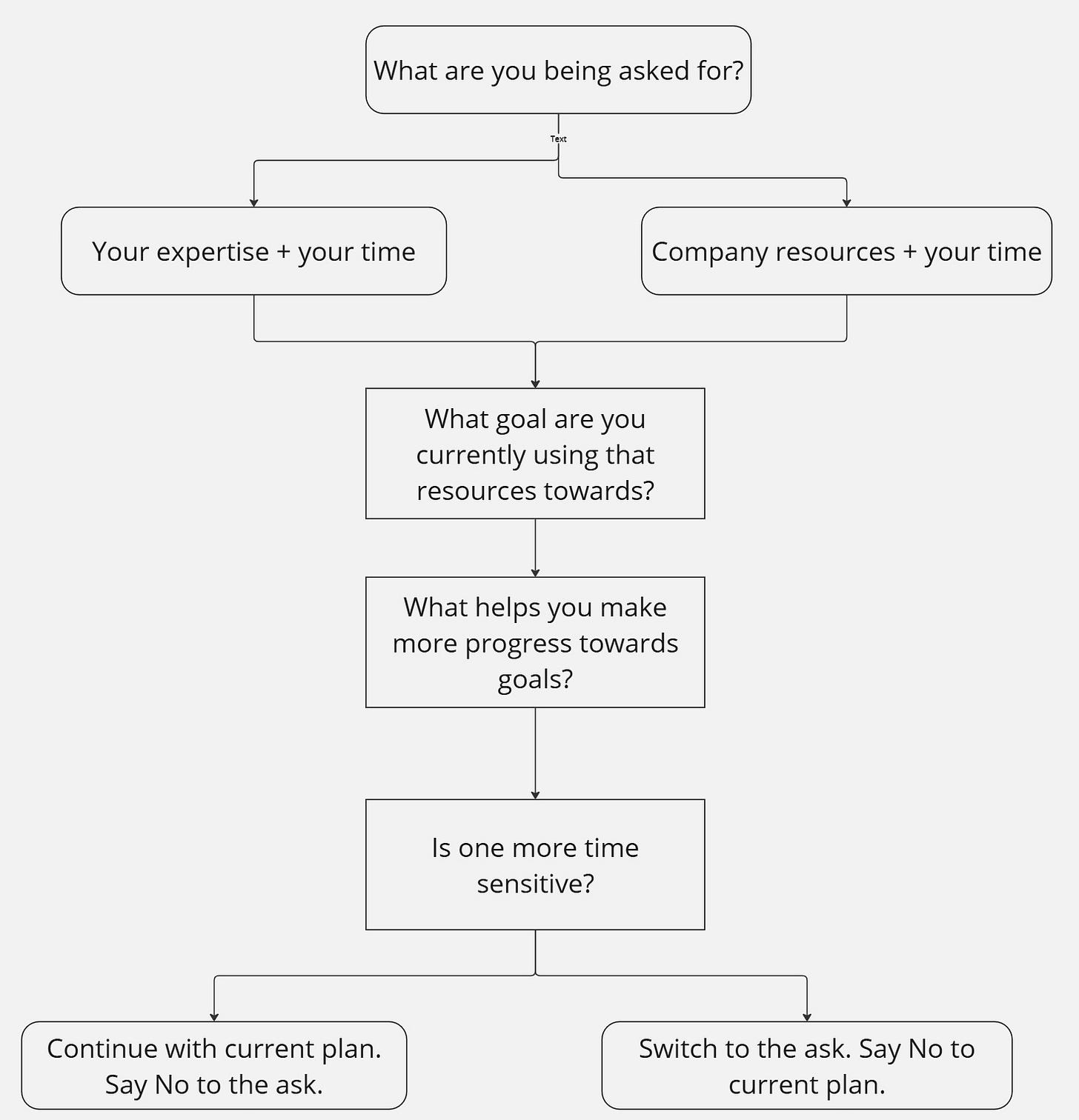Learning to say No (Part 1 of 2)
Are you saying ‘No’ or ‘Not right now’ or ‘I don’t know and here’s what’s needed to decide yes/no’
“The difference between successful people and really successful people is that really successful people say no to almost everything.” – Warren Buffett
This post is part of ongoing series on Most Under-rated skill for young professionals. Read previous post here: Get good at getting feedback
“Hey, I know it’s a little last minute, but can you finish this deck tonight?”
“Okay, but can we at least try the idea? Let’s test it and then take a call.”
How many times have you done something – something that you didn’t think was a great idea or something that you didn’t have the time for – but you said yes, only because it was too difficult to say ‘no’?
Saying ‘no’ isn’t a skill that we’re often equipped with at the start of our careers. But as the guardians of company’s resources; and responsible for how we use our time - that one non-replenishable resource - learning to say no is super important skill. Saying ‘no’ preserves our time and resources for things that matter most. Saying no for the right reasons also earns us credibility and trust with our stakeholders.
The good news saying ‘No’ is a skill that can be developed with practice. The first step is to be clear on why you’re saying no. Remember you’re not saying no because of any personal preferences; you’re declining because it’s not the best use of whatever resources is being asked for. And often, your no is actually a ‘not right now’ or ‘I don’t have enough data to decide.’
If you received this from a friend, please subscribe to The Career Starter Kit to receive it directly in your inbox every week.
Here’s how you figure it out:
Step 1: Identify: What are you being asked for?
Usually, you’re being asked for one of two things: some company resources you’re accountable for; or your expertise.
Let’s run this offer? That’s an ask for company budgets.
Review this code? That’s an ask for expertise.
Usually, you can never just give a resource without also giving your time. So, any ask becomes an ask of your time as well.
Let’s run this offer? An ask for company budgets + your time (to set up, run and review the campaign)
Review this code? An ask for expertise + your time (to review the code)
For all practical purposes, every ask is an ask of either: your expertise + your time or company resources + your time.
Step 2: Identify: How is that resource currently being used?
Whatever you’re being asked for, odds are, that resource is already committed elsewhere.
The (budget+time) needed to run the discount? They’re allocated to some other offer.
The (expertise+time) needed to review the code? That’s allocated to testing some other code.
Whatever resource being asked for, you’re already using it to make some progress towards some goal. Identify that.
Step3: Compare and Decide: Which will help you make more progress? Is something more time sensitive?
Now compare the ask versus your current plan. Think of it as a lightweight prioritisation exercise.
If you spend this afternoon reviewing the new code (ask) vs testing code (current plan) – which helps you make more progress towards your goals? Let’s say the code you are testing was for a minor bug; but the new code you’re being asked to review is for a major new launch. You’d switch your plans and review the new code.
Maybe one is less time sensitive- so you continue with the code test today; and review the new code tomorrow. Now, instead of saying ‘no’, you’re saying ‘not now’.
Do we really do this every time we have to decide on an ask?
You might be thinking, “these steps sound logical, but also time consuming. Do we really do this every time we have to decide on an ask?”
Here’s the thing. These steps are really to nudge you to do a lightweight prioritisation exercise every time you’re asked for a resource. Sometimes this can be straightforward. You’re spending tomorrow afternoon mentoring a junior from college. Your manager asks you to prepare a deck for a leadership review. What do you choose? You prioritise working on the deck and re-schedule the session with junior because its less time sensitive.
With practice, this prioritisation gets easier. It becomes muscle memory. It’s worth investing time in practicing this skill because if you’re comfortable saying no, you’re able to preserve your time and resources for the most important things.
But, sometimes, the prioritisation exercise isn’t so lightweight. Making the comparison between the current plan and the new ask can be time consuming. Let’s say, your plan is to run X discount in upcoming sales. The partner team asks you to run Y discount instead. Your criterion is to run the plan that delivers minimum 2X ROI; but you don’t know the ROI of the proposed discount; and you don’t have time to do the math. What do you do?
Sometimes, we default to "no" simply because we lack information to prioritise. Take the discount offer request—your instinct may be to reject it, but the real issue is unclear ROI and lack of time. Instead of rejecting the ask, share your prioritisation criteria and ask for help: "That sounds promising, but I don’t have resources to evaluate it. Here’s how we assess promos—can you fill in these details?" This shifts the conversation from rejection to consideration. If it works, great; if not, both parties will be on the same page as to why.
Being transparent about your constraints and using clear criteria make smarter decisions possible.
Putting things into practice:
Identify: What are you being asked for? What goals are you currently using that resource towards?
Compare and decide: Which option helps you make more progress: your current plan or the new ask?
As you reflect on these, you’ll often realise, that your ‘No’ is actually a ‘Not right now’ or ‘I don’t know and here’s what’s needed to decide yes/no.’
Once you’re clear on the why, it becomes easier to communicate the ‘No’. We get to that in Part 2 of this post.






